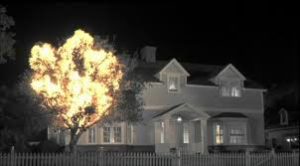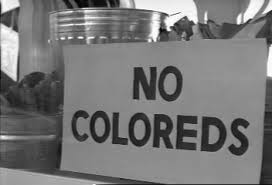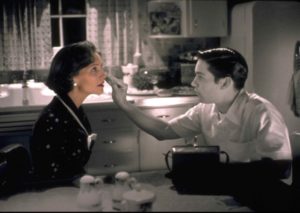Washington Post cartoonist Tom Toles recently did a post he titled “It’s Back to The Future with Trump’s 2020 campaign.”
Actually, I think the more accurate movie analogy for Trump and his MAGA supporters is the political allegory Pleasantville (1998). As Roger Ebert described it:
The movie opens in today’s America, which we have been taught to think of as rude, decadent and dangerous. A teenager named David languishes in front of the tube, watching a rerun of a 1950s sitcom named “Pleasantville,” in which everybody is always wholesome and happy …
Longing for a simpler time, in an idealized version of the 1950s that never really existed in reality.
While David and [his sister] Jennifer are fighting over the remote control, there’s a knock at the door and a friendly TV repairman (Don Knotts) offers them a device “with more oomphs.” They click it, and they’re both in Pleasantville.
Director Garry Ross “evokes the black-and-white 1950s sitcom world of picket fences and bobby sox, where everybody is white and middle class, has a job, sleeps in twin beds, never uses the toilet and follows the same cheerful script.”
In this idealized version of the 1950s there are no African-Americans, or Latino or Asian immigrants, or gays and lesbians, or women demanding “rights.” It is a world of white male privilege, and everyone else had damn well better understand their place in this world. This world was never idealized by African-Americans, or Latino or Asian immigrants, or gays and lesbians, or women demanding “rights.” And they are not going back.
In this sitcom world, David and Jennifer “are now Bud and Mary Sue, and their parents are Betty and George Parker.” “Life always goes according to plan, and during basketball practice every shot goes in.”
“Pleasantville” has fun during these middle sequences, as “Bud and Mary Sue” hang out at the malt shop where Mr. Johnson (Jeff Daniels) works and park on Lover’s Lane  (just to hold hands). Then sparks from the emerging future begin to land here and there in the blandness. Mary Sue shares information about masturbation with her mother, who of course has never dreamed of such a pastime (as a perfect housewife, she has never done anything just for herself). As her mother relaxes in her bath, a tree outside their house breaks into flames–in full color!
(just to hold hands). Then sparks from the emerging future begin to land here and there in the blandness. Mary Sue shares information about masturbation with her mother, who of course has never dreamed of such a pastime (as a perfect housewife, she has never done anything just for herself). As her mother relaxes in her bath, a tree outside their house breaks into flames–in full color!
The Rational Optimist adds: “There’d never been a fire in Pleasantville, and the firemen don’t know what to do. Dave (Bud) shows them, and puts the fire out, becoming the town hero. This gets Dave (Bud) a girlfriend, Margaret, who’d been someone else’s girlfriend.”
Ross and his cinematographer, John Lindley, work with special effects to show a black-and-white world in which some things and a few people begin switching to color.
 The Rational Optimist adds: “Its still mainly black-and-white population sees the colorized minority as a threat to its way of life, and conflict brews, even turning violent. In one scene, Margaret’s ex-boyfriend accosts the pair and ends with a taunt about “your colored girlfriend.” Soon we see a shopkeeper putting up a sign: NO COLOREDS.”
The Rational Optimist adds: “Its still mainly black-and-white population sees the colorized minority as a threat to its way of life, and conflict brews, even turning violent. In one scene, Margaret’s ex-boyfriend accosts the pair and ends with a taunt about “your colored girlfriend.” Soon we see a shopkeeper putting up a sign: NO COLOREDS.”
This is what Trump and his MAGA supporters fear most. As William F. Buckley famously described, “A conservative is someone who stands athwart history, yelling Stop, at a time when no one is inclined to do so, or to have much patience with those who so urge it.” The coming “browning of America” and the waning of white male privilege frightens them, so they yell “Stop!” and long for an idealized past that never really existed in reality.
But the future is coming, and time cannot be turned back.
The kids at school are the first to start appearing in colors. They’re curious and ready to change. They pepper Bud with questions. “What’s outside of Pleasantville?” they ask. “There are places,” he says, “where the roads don’t go in a circle. They just keep going.”
 Bud shows Mr. Johnson a book of color art reproductions, and the soda jerk is thunderstruck by the beauty of Turner and Van Gogh. He starts painting. Soon he and Betty Parker have discovered they’re kindred spirits. (After Betty turns up in color, she’s afraid to show herself, and in a scene of surprising tenderness, her son helps her put on gray makeup.)
Bud shows Mr. Johnson a book of color art reproductions, and the soda jerk is thunderstruck by the beauty of Turner and Van Gogh. He starts painting. Soon he and Betty Parker have discovered they’re kindred spirits. (After Betty turns up in color, she’s afraid to show herself, and in a scene of surprising tenderness, her son helps her put on gray makeup.)
George Parker, meanwhile, waits disconsolately at home for his routine to continue, and the chairman of the Chamber of Commerce (J.T. Walsh) notes ominously, “Something is happening in our town.”
The film observes that sometimes pleasant people are pleasant simply because they have never, ever been challenged. That it’s scary and dangerous to learn new ways.
Something is happening in towns across America, and it is scary. The American economy is being transformed from the industrial era to the information age, where computers and robotics, and soon artificial intelligence will replace human labor. 47 percent of total U.S. employment is at risk, according to a 2013 study by Carl Benedikt Frey and Michael A. Osborne of Oxford University. The Future of Employment: How Susceptible Are Jobs to Computerisation? (.pdf).
The jobs of the future are being relocated to large urban centers where skilled, educated workers live. Small towns in rural America are disappearing as industry and traditional jobs disappear. Corporate farming has replaced the family farmer, who has already disappeared. And clean energy is rapidly replacing carbon-based energy. The “creative destruction” of capitalism is causing massive economic disruption just as the previous Industrial Revolutions did. The Fourth Industrial Revolution brings promise and peril for humanity.
American politicians have not figured out how to address this massive economic disruption, nor how to alleviate the fears of Americans over loss of employment, income and wealth disparity, and the loss of a way of life to which they have been accustomed.
This failure to address rapid economic change and the unease and fears of Americans has allowed racist demagogues like Donald Trump to jump in to fill the void by blaming “others” for their predicament, i.e., immigrants, and minorities, and unfair foreign trade.
The movie is like the defeat of the body snatchers: The people in color are like former pod people now freed to move on into the future. We observe that nothing creates fascists like the threat of freedom.
“Pleasantville” is the kind of parable that encourages us to re-evaluate the good old days and take a fresh look at the new world we so easily dismiss as decadent. Yes, we have more problems. But also more solutions, more opportunities and more freedom. I grew up in the ’50s. It was a lot more like the world of “Pleasantville” than you might imagine. Yes, my house had a picket fence, and dinner was always on the table at a quarter to six, but things were wrong that I didn’t even know the words for.
The Rational Optimist adds: Pleasantville is a “metaphor for change, knowledge, and liberation.”
“Of course, the revolution triumphs. In the end, all Pleasantville emerges into glorious color. And there is a world outside it[.]”
Discover more from Blog for Arizona
Subscribe to get the latest posts sent to your email.
